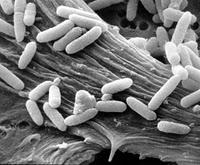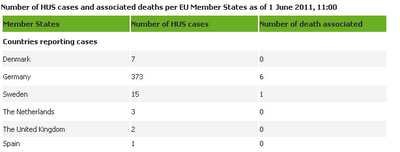 Ieri, la Commissione Europea ha prodotto due press release di aggiornamento sul focolaio epidemico da Escherichia coli che sta investendo la Germania e parte dell'Europa. In una, prende nota delle analisi compiute dalle autorità tedesche e spagnole, che scagionano i cetrioli spagnoli
Ieri, la Commissione Europea ha prodotto due press release di aggiornamento sul focolaio epidemico da Escherichia coli che sta investendo la Germania e parte dell'Europa. In una, prende nota delle analisi compiute dalle autorità tedesche e spagnole, che scagionano i cetrioli spagnoliEfforts intensify to identify source of E. coli outbreak in Germany as final tests clear Spanish cucumbers
Today, the latest results of the tests on cucumber samples, carried out by the competent authorities of both Germany and Spain, showed that the Spanish vegetable is not responsible for the Shiga toxin-producing E. Coli (STEC) outbreak affecting Germany and other Member States.The German competent authorities officially informed the European Commission this afternoon that they have concluded all tests on the samples they collected. Despite the fact that some of the sampled cucumbers did test positive to STEC, the tests did not confirm the presence of the specific serotype (O104), which is responsible for the outbreak affecting humans. Similar tests carried out by the Spanish authorities on cucumber samples they collected have also rendered negative results. After this development, the European Commission has removed the alert notification on Spanish cucumbers from the Rapid Alert System on Food and Feed.Investigations are still ongoing to identify the potential source of contamination. In a press conference this morning, Health and Consumer Policy Commissioner John Dalli stressed: "I urge the Member States and in particular Germany to increase their efforts in that direction. We stand next to them and we will do our outmost to assist in any possible way."
 In sostanza, dichiara che dopo che le autorità competenti di Germania e Spagna hanno effettuato i test sui cetrioli trovandoli negativi, la Commissione richiede il massimo sforzo, soprattutto ai tedeschi ma anche agli altri stati membri, per identificare il o i vettori di questo contagio. E' da notare che i tedeschi riferiscono che i cetrioli risultano tutti negativi alla presenza di STEC (Shiga toxins-producing Escherichia coli) per il sierotipo O104, che è quello responsabile dell'infezione sull'uomo, anche se alcuni cetrioli risultano positivi alla presenza di STEC di altro sierotipo. Nell'altra conferenza stampa, John Dalli Commissario Europeo alla Salute, dichiara
In sostanza, dichiara che dopo che le autorità competenti di Germania e Spagna hanno effettuato i test sui cetrioli trovandoli negativi, la Commissione richiede il massimo sforzo, soprattutto ai tedeschi ma anche agli altri stati membri, per identificare il o i vettori di questo contagio. E' da notare che i tedeschi riferiscono che i cetrioli risultano tutti negativi alla presenza di STEC (Shiga toxins-producing Escherichia coli) per il sierotipo O104, che è quello responsabile dell'infezione sull'uomo, anche se alcuni cetrioli risultano positivi alla presenza di STEC di altro sierotipo. Nell'altra conferenza stampa, John Dalli Commissario Europeo alla Salute, dichiaraGood morning,Over the past few days, we have been facing a serious crisis. My thoughts are with the victims and their families and those who have lost loved ones to whom I extend my most sincere condolences.According to the latest information, this outbreak of E. coli is responsible for nine (9) deaths in Germany and one (1) in Sweden. In Germany, 1,169 cases have been recorded. Out of these, 373 developed the more serious form of the disease, the so-called HUS. Sporadic cases are reported in seven other Member States. Switzerland has also reported two cases and the United States three.The epicentre of the disease is the area around Hamburg in the northern part of Germany. Most of the cases reported outside this Member State concern either German nationals travelling or persons who visited the country.Now… what have we done to cope with this rapidly developing situation?In short, and as the joint statement testifies, we have been working hand-in-hand with the Member States with one common goal – to bring this outbreak to an end as soon as possible. In order to do that, we need to take all efforts to rapidly identify the source of contamination. The initial suspicion of the German authorities that cucumbers from Spain were the cause has not been confirmed by the test results available up to now. Despite the fact that the sampled cucumbers did test positive to E. coli, they did not confirm the presence of the specific serotype which is responsible for the outbreak affecting humans. Intensive work is taking place to pinpoint the source of contamination. While recognising the huge efforts invested by all, I urge the Member States and in particular Germany to increase their efforts in that direction. We stand next to them and we will do our outmost to assist in any possible way. In the meantime, the public should remain calm and keep applying basic hygiene rules when preparing food. Before closing, I would like to raise briefly two more points:The first concerns references to ban certain products. I would like to stress again, in the strongest possible way, that the outbreak is limited geographically to an area surrounding the city of Hamburg. Furthermore, according to the latest information we have available from Germany, it appears that the outbreak is on decline – fewer people have been hospitalised over the past couple of days than before. Let us also keep in mind that efforts to pinpoint all possible sources of contamination are ongoing. We would, therefore, consider any ban on any product as disproportionate.Finally, we are also very sensitive to the financial impact that this crisis is already having on farmers, in particular, vegetable producers. What I can say at this moment, is that I am working closely with my colleague – Commissioner Dacian Ciolos – to address the hardship faced by this group of our citizens that has also been hit hard by the E. coli outbreak.Fruit and vegetables need to be washed thoroughly. The same applies for hands before preparing food or eating, and after using the bathroom or changing diapers. Washing thoroughly knives, plates and other utensils limits the risk of cross-contamination.Thank you for your attention.
- We activated immediately all our networks responsible for managing crises. As they are in daily contact, the networks allow for the timely exchange of information thus laying the ground for rapid action.
- We have asked the European Centre for Disease Prevention and Control (ECDC) to do a risk assessment. It delivered in two days.
- Our EU reference laboratory in Rome developed a method that reduces the time needed to detect the E. Coli bacterium in food, from about six days to 48 hours. This was also achieved in record-breaking time – it took about a week to do it.
- The Commission services –at all levels– have been in constant contact with the national authorities and other involved parties through all possible means: phone calls, audio-conferences, meetings. The last one was yesterday's Standing Committee on the Food Chain and Animal Health, where the Member States endorsed a joint statement on the issue.
Fino ad ora, possono attribuirsi a E. coli 9 decessi in Germania e 1 in Svezia. In Germania ci sono stati 1169 casi di infezione e, oltre a questi, 373 di sindrome emolitico-uremica (HUS). Casi sporadici sono stati segnalati in altri 7 paesi membri, 2 in Svizzera e 3 negli Stati Uniti.L'epicentro sembra essere la zona intorno ad Amburgo. Elenco dei provvedimenti presi:
- Immediata attivazione di una rete di monitoraggio per scambio informazioni
- Richiesta al European Centre of Disease Prevention and Control di una valutazione dei rischi
- Il laboratorio di riferimento a Roma ha sviluppato un test rapido per identificare E. coli: 48 ore contro 6 giorni
- Costante contatto con tutti gli stati membri e le autorità nazionali






